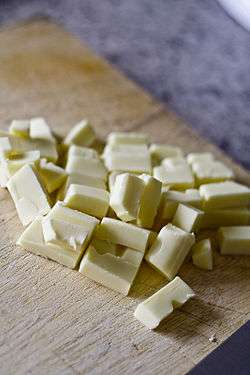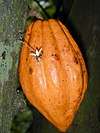White chocolate
 Pieces of white chocolate | |
| Type | Chocolate derivative |
|---|---|
| Main ingredients | cocoa butter, sugar, milk solids |
| Ingredients generally used | salt |
White chocolate is a chocolate derivative. It commonly consists of cocoa butter, sugar and milk solids and is characterized by a pale yellow or ivory appearance. The melting point of cocoa butter, white chocolate's only cocoa bean component, is high enough to keep white chocolate solid at room temperature, just like milk chocolate or dark chocolate.
Composition
White chocolate does not contain non-fat cocoa solids, the primary constituent of chocolate liquor — chocolate in its raw, unsweetened form. During manufacturing, the dark-colored solids of the cocoa bean are separated from its fatty content, as with milk chocolate and dark chocolate. As a result, this cocoa butter is the only cacao ingredient in white chocolate. Because it contains no cocoa solids, white chocolate contains only trace amounts of the stimulants theobromine and caffeine. White chocolate may include additional flavorings, such as vanilla.[1]
Regulations
Regulations govern what may be marketed as "white chocolate": In the United States, since 2004, white chocolate must be (by weight) at least 20% cocoa butter, 14% total milk solids, and 3.5% milk fat, and no more than 55% sugar or other sweeteners.[2] Before this date, American firms required temporary marketing permits to sell white chocolate. The European Union has adopted the same standards, except that there is no limit on sugar or sweeteners.[3]
History
In the 1930s, the white chocolate Milkybar was launched in Europe by Swiss company Nestlé.[4]
In North America, Kuno Baedeker developed a white chocolate while working for the Merckens Chocolate Company in 1945.[5]
See also
References
| Wikimedia Commons has media related to White chocolate. |
- ↑ Blumberg, Naomi. "Chocolate". Encyclopædia Britannica Online. Retrieved 28 July 2015.
- ↑ "Title 21 Chapter I Subchapter B Part 163 of the Code of Federal Regulations". United States Government Publishing Office. 24 February 2017. Retrieved 27 February 2017.
- ↑ "Directive 2000/36/EC of the European Parliament and of the Council of 23 June 2000 relating to cocoa and chocolate products intended for human consumption". Retrieved 27 October 2010.
- ↑ "The History Of White Chocolate". The Nibble. The World’s Best White Chocolate. 1 April 2008. Retrieved 2 August 2013.
- ↑ "Chocolate-Loving Couple Settled Here" (PDF). Lake Placid News (PDF). Lake Placid, New York. 19 March 1987. p. 8. Retrieved 2 August 2013.
